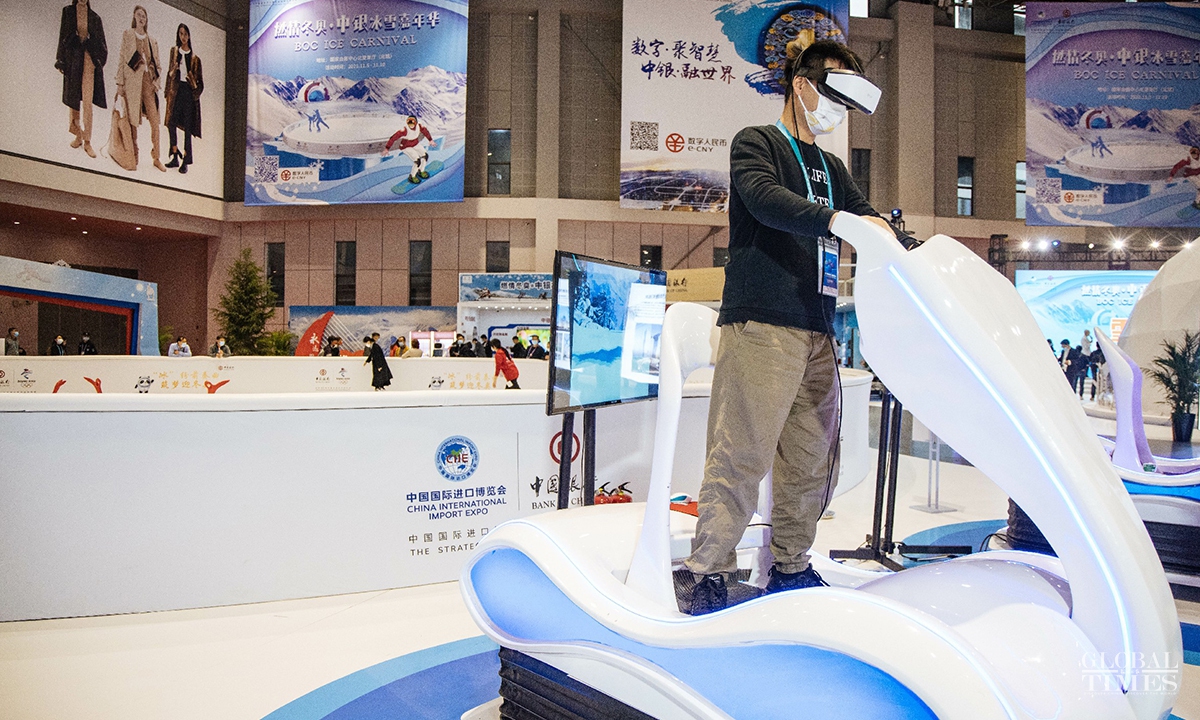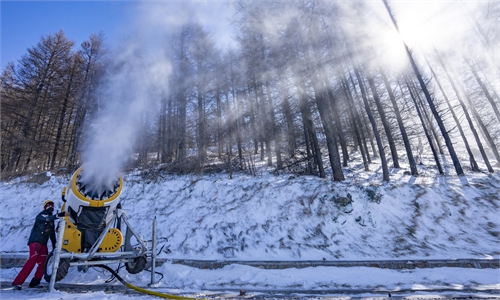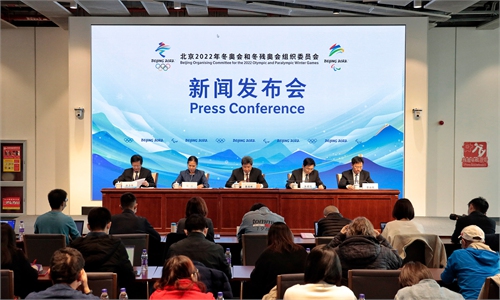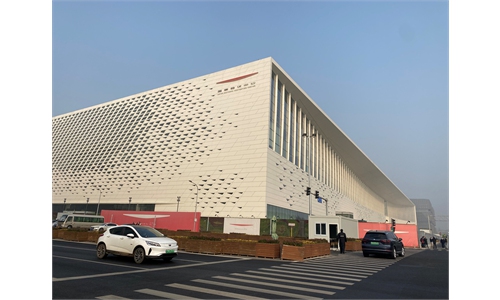China will demonstrate its commitment to the concept of a green Olympics by using a number of high-tech tools for the first time in the history of the Games to ensure that the goal of carbon neutrality is achieved throughout the Beijing Winter Olympic Games, the Global Times has learned.
These technologies will also provide intelligent medical care for the athletes, enjoyment for the spectators and epidemic prevention support for all attendees to ensure that there are no mass infections, the Beijing Organizing Committee (BOC) for the 2022 Winter Olympic and Paralympic Games said at a news conference on Thursday.
While the ongoing pandemic requires that this Olympic Games be held under closed-loop management, it will still be open and inclusive, observers noted. Once the Games begins, high technology will also ensure that the media can report accurately and quickly and that spectators can enjoy the event without delays and from multiple perspectives.

CIIE exhibitors gear up for the upcoming Beijing Winter Olympics Photo:Li Hao/GT
High-tech firsts
For the first time, explorers on top of Mount Qomolangma, commonly known in the West as Mount Everest, will be able to watch live broadcasts of the Olympic Games through 5G signals from the highest point of the world, as Beijing has made sure that 5G towers for Olympic broadcasts have been set up on the mountain.
The Beijing Organizing Committee built the 5G signal tower for broadcasting to an altitude of 5,000 meters above sea level and achieved 5G signal coverage for the Observation Deck and Camp 1, the first time this has been done in the history of the Olympic Games. This means that 5G signal will cover all Winter Olympic venues and roads and railways connecting them.
Ordinary viewers will have the opportunity to enjoy the world's clearest broadcast technology, 8K broadcast in ultra high definition, from TV sets in their homes. Viewers will also be able to experience the games in virtual reality (VR), according to the Organizing Committee.
In addition to the broadcast, a number of Olympic high-technologies are also being applied for the first time in Beijing.
The "Ice Cube," a curling arena transformed from the former Beijing Summer Olympic Games' swimming pool, is the first venue in the world to achieve a "water-ice transition." Based on rapid disassembly and leveling dynamic monitoring technology, the swimming pool can be transformed into a curling rink within 20 days.
The Winter Olympic Games weather forecasting system developed by the meteorological team can achieve accuracy to every 100 meters and every minute, the highest in Olympic history, Yu Hong, head of the technical department of the Organizing Committee, said on Thursday.
During the test event in February, the Organizing Committee made adjustments to the schedule for 12 games and training sessions based on weather forecasts, Yu said.
Representatives of the Organizing Committee said they will also carry out contactless rapid security checks, and manage the passenger flow of outdoor venues in real time through holographic projections.
In terms of intelligent medical care, Zhangjiakou has set up a rescue and treatment early warning system and an information platform connecting the ski resort and Chongli hospital, said Li Congmin, deputy head of the Hebei Provincial Department of Science and Technology.
"We built a closed-loop, integrated medical treatment system from the race course to the medical station, ambulance, helicopter and then to the designated hospital, solving the problem of remote medical services on the way to the emergency transfer, providing fast, high-quality, high-efficiency treatment for injured athletes," Li said.
High-tech COVID-19 prevention
The high technologies will also be used to tackle the toughest challenge facing the Games - COVID-19 prevention and control.
"To provide timely warning of possible environmental risks, a team of scientific and technical experts of the Beijing Winter Olympic Games developed an aerosol environmental virus monitoring system for public spaces, automatically examining air at various locations in the venues and providing timely warning to staff when positive results for COVID-19 occur," Zhao Weidong, head of the press and publicity department of the Beijing Olympic Organizing Committee, said at Thursday's news conference. "The technology provides three times more accuracy than previous monitors."
"In terms of disinfection and sterilization, on the basis of traditional disinfectants, we try to apply new technical means from many aspects, such as molecular sieve micro-nano-catalytic filter material disinfection, ultraviolet disinfection, plasma disinfection, and so on," Yu said at the news conference.
To ensure the safety of media workers in the media center and prevent cross-infection or cluster infection, the center has deployed robots for various missions, including guidance, food and package delivery, disinfection and sanitation, among others.
People's entire movement trails will be tracked by a central control platform that manages all the cameras and access to the venues. As different sections for closed-loop management will be set up during the Games' broadcasts, access controls will give authorization to certain places for various personnel, ensuring they can only swipe in to the areas they are allowed to.
In addition, an anti-epidemic checking and monitoring system can help ensure the stable functioning of the venues. For example, once a person develops a fever or other COVID-19 symptoms, the system can track the person's close contacts and where they have been, allowing for more accurate and convenient location and epidemic screening tests.
Ensuring carbon neutrality
Apart from the high technology, the Games is also committed to meeting the goals of sustainability and energy efficiency.
"The Beijing Winter Olympic Games will be carbon neutral," Zhao said.
To achieve this goal, the Beijing Winter Olympic Games has opened the power transmission project, bringing wind and solar energy production of green electricity from surrounding areas into Beijing, to ensure that all venues will achieve 100 percent green electricity supply.
In all the ice project venues, the entire process of ice-making will use carbon dioxide, bringing carbon emissions close to zero. The large scale application of this technology is another first in the history of the Olympic Games.
Biodegradable tableware produced from renewable resources such as corn, potatoes and straw will replace plastic products during the Games.
The air conditioning units and central ventilation system in the venues are set up with full heat recovery devices, with a recovery efficiency of 70 percent, saving energy when air conditioning is used, the Global Times has learned.
Artificial snowmaking will also have no impact on regional water security or ecology, Zhao explained when asked of the potential risks.
According to data provided by the Beijing Water Authority, water demand at the Winter Olympic Games will account for 1.6 percent of the total current water consumption in the city's Yanqing district, and only 0.4 percent of the local water resources.
This means there will be no water shortage in Yanqing, and the amount of water used during the Winter Olympic Games will not have any impact on the area's water security, Zhao said.
The same goes with the Chongli ski resort in Zhangjiakou, North China's Hebei Province, with the water demand for Chongli accounting for 9.8 percent of the total water consumption in Zhangjiakou.
Meanwhile, the city has carried out a water transfer project from its Yunzhou Reservoir to Chongli to effectively reduce the amount of groundwater extraction in the district and preventing lowering of the groundwater level. The project has transferred a total of 5.2 million cubic meters of water to Chongli so far.
The artificial snow-making system for the Beijing Winter Olympic Games has adopted the world's most advanced equipment characterized by its high-efficiency in water saving, enabling it to maintain the highest snow-making efficiency in accordance with the dynamics of the external environment, the Global Times has learned.
Through the real-time monitoring of weather and other conditions, the system can choose the most suitable conditions to launch the machines so as to avoid waste of water resources, Zhao said, in response to a question raised by a foreign reporter who was one of dozens present at the news conference on Thursday.
Zhao also noted that last week, the Organizing Committee specially invited nine foreign media members to participate in a mini-symposium and discussed numerous issues that raised concerns.
Since 2020, journalists from foreign countries have been arriving in Beijing to lay broadcast equipment and cover the test events. More than 300 foreign journalists who will report on the Winter Olympic Games are already in Beijing, and will be able to enter the public domain after completing their 21-day quarantine, leaving closed-loop management and having unrestricted coverage, Zhang said.



